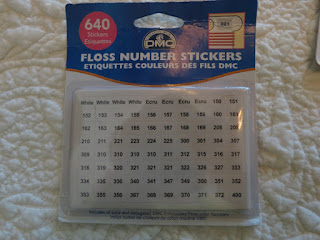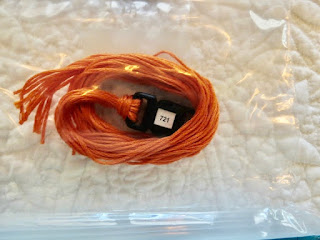I have dealt with different methods of managing embroidery floss. At one time, I had a beautiful, limited edition DMC chest. It was more like a piece of furniture, than a simple storage option. It was very heavy, too. Needless to say, I do not have it anymore.
Most commonly in the past, I've used the floss cards, stored in photographic plastic protectors for 35mm slides, held together with binder rings. My DMC collection is in two parts.
Lately, I've used cards (I prefer plastic), plastic bags, and bins. The floss is stored in a "kitted" form with patterns and fabrics, whenever possible. But I longed to have a "uniform" system for all my fibers. I didn't know what I was going to use, until I thought of using the small, plastic, contour buckles that are popular with paracord bracelets.
What I Wanted in a System
Before arriving at the buckle system, there were several features I wanted that system to possess.
- I wanted a system that would allow me to hold and store skeins and precut threads. I typically like to pre-cut floss to 36"-40" lengths so I can use a no-knot start, if possible. If not, I just cut the longer length in half.
- I also wanted to avoid winding the threads onto cards. It's not hard, but time consuming. Plus, the cards put kinks in the floss, even though it's not that important once the floss is stitched.
- It had to be sturdy, as I am not easy on anything, especially something that I hand frequently.
- I like that the buckle portion and the tongue portion do not need to be stored together. I can keep them in separate areas.
- I wanted to be able to ID the threads with the system, without extra tags.
- I wanted to be able to put the threads in bags in loose coils, or on rings, or ?
So, I found some small (3/8") contour buckles on Amazon. They make larger buckles, but I wanted the smaller ones.
I would have preferred white, but the black ones were cheaper. One could buy buckles of different colors to use to identify different companies, such as black for DMC, beige for Weeks Dye Works, etc. Or, you could use a single color of buckles for each project. Next, I needed a way to identify the floss. For DMC, I was in luck. See the little raised rectangle on the front of the buckle?
Well, you're probably familiar with the pre-printed DMC labels:
They fit PERFECTLY into that little rectangle!
To use my system, I just take a skein of DMC floss, cut it into 8 equal pieces, then attach it to the buckle loop with a simple overhand knot or a lark's head knot (which I use). I coil them up loosely, and put them in a floss bag (one or more per bag) for storage.
Now, about those other flosses...
What would be perfect for marking the buckles is a white, silver, gray, or other light color permanent marker with an ultra fine tip. But, I only had black, which is no muy bueno for the black buckles. I did have a thick silver Sharpie, though:
Black shows up on the silver, so, I just "colored" the back of the buckle with the silver Sharpie. Then I wrote in the name with the black Sharpie. Here, I'm marking buckles for Weeks Dye Works threads. I don't have inherently "pretty" handwriting, but it would be nice if I did! I suppose I could have printed up tiny "labels" and glued them to the back. But, that would have taken a lot more time.
By the way, Sharpie can be removed with acetone (fingernail polish remover). The silver is a bit more persistent, but mistakes can be corrected, or buckles changed.
These flosses are for a specific project I just started. So, I flipped the buckles over and inserted the corresponding chart symbols into the little rectangles with the silver Sharpie.
The buckles are called "contour" for a reason. They are supposed to curve gently to correspond to your wrist (on the left in the photo below). I didn't need a curve, and although this step is unnecessary, I inserted the "tongue" into the buckle in the opposite direction, creating an "S" shape instead of a curve (on the right in the photo below):
Then I put all the flosses on a 21/2" ring through the tongue loop.
The 3/8" buckles have small openings or "loops." So, you cannot use the thicker binder rings with them, such as the one below, but you may be able to use that particular ring with larger buckles.
Now, it's all ready to hang on my frame!













